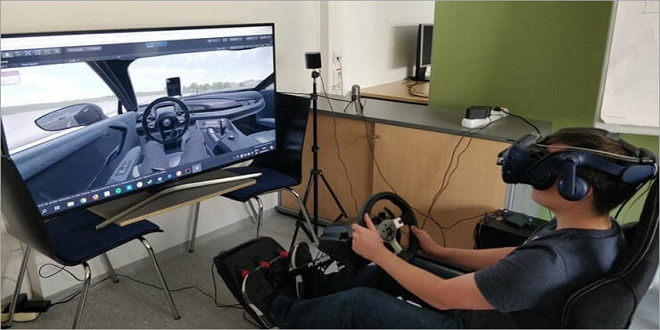What is VR?
Virtual reality (VR) is a term used to describe computer technology that creates a simulated environment in which the user is placed. The user isn’t limited to looking at things on a screen, as they can interact with immersive 3D worlds. These environments aren’t real; rather, they are virtual because to this fact.
However, virtual reality technology may be used to produce experiences that are realistic and immersive. You might explore the world the computer creates, and it stimulates your senses in a remarkable way. The user believes they are present in the virtual reality environment both physically and mentally, making it an intriguing concept. VR has been around for a long time as a notion.
Creating something that draws the viewer in, or user, dates back to around 200 years ago. For example, in the 18th and 19th centuries, painters produced canvases of wide vistas with the aim of transporting the viewer into an immersive environment.
The stereoscope was quite popular in Victorian London. This gadget created three-dimensional virtual worlds by combining two photographs. Modern VR is more advanced, and it uses critical technological components as its basis.
How Does Virtual Reality Work?
The basic technology that allows virtual reality to work is called eye-tracking. To do so, it must deceive the brain into believing the simulated world is behaving similarly to the real one it is attempting to replicate.
The brain must analyse and comprehend sensory data. Our perception of the world around us is determined by our interpretation of it. Our perception is created by the interaction of various stimuli. As a result, the objective of VR technology is to alter how we perceive what we are seeing.
It accomplishes this by combining a variety of components, including:
- Stereoscopic vision
- Head tracking
- Eye tracking
- Motion tracking
The vehicles for mixing these technological elements into a user experience are:
- VR headset
- VR projection
Stereoscopic vision
The stereoscope, as well as earlier devices like the panoramic and cyclorama, were early examples of a device that delivered an immersive experience for the viewer. Stereoscopic vision is an important component of VR technology. Binocular vision is required for someone to perceive something three-dimensional. The left and right eyes have slightly varied points of view.
The brain combines these two streams of information together in a technique known as stereopsis. We observe in stereo. Each eye must perceive the image differently to achieve this effect in VR, which is something a headset can accomplish. VR projection uses multiple projector technology to create large-screen stereoscopic experiences.
Head tracking
The majority of the time, it’s necessary to take your eyes off the screen to actually see what you are looking at. This is one method for getting around this problem: by moving your head in a variety of directions, you can explore different settings in an interactive VR scenario. Motion is an important component of virtual reality experiences. If a VR headset merely displayed the same stereoscopic picture regardless of whether we looked up or down, or side to side, it would soon become unconvincing. In essence, head tracking sensors deceive the brain by monitoring movement and direction of motion. Head tracking sensors track the direction that a viewer’s head is pointed in order to detect motion and orientation .
The system tracks the head by plotting it on an XYZ plane and measuring head movements. Depending on the sophistication of the VR device, head tracking performance may vary significantly. High-end headsets employ sophisticated sensors like cameras, infrared LEDs, and magnetometers for precise tracking. Smartphones, for example, use accelerators and gyroscopes to track head movement instead of more advanced motion sensors. For additional information about motion sensors, see below.
Eye tracking
Eye tracking takes place in the unconscious mind of the user and is based on his or her subconscious responses and actions. This is a more sophisticated form of tracking that relies on continuous measurements of the distance between a pupil’s centre and its reflection in the cornea. An infrared light produces the reflection, while built-in cameras record and track movement.
The human gaze can be tracked by complex computer algorithms from the recorded eye angle. Eye tracking may also improve VR because it only requires the processing power to render those elements of the virtual environment that the eye is looking at. It also makes the virtual world more similar to reality, resulting in a more immersive experience.
Motion tracking
For a VR experience to feel real, the user should be able to mimic reality as much as possible by moving within the virtual world. The virtual self becomes immobile without motion, decreasing or eliminating the immersive effect. The total body is immersed in the premium immersive experience.
Obviously, in some virtual activities, such as driving a vehicle or flying an aircraft, full body motion is not required. The experience must, however, capture a sufficient range of motion to make things seem genuine. Six degrees of freedom (6DOF) is the term used to describe how a rigid body moves freely in three dimensions. It has two primary categories:
- Optical tracking
- Non-optical tracking
Optical tracking is based on cameras to track body movement. Cameras and optical markers are typically used in this approach. These reflectors might be passive or active, either reflecting light or being computer-controlled LEDs. In consumer VR headsets, active optical tracking is not widely utilized.
Optical tracking methods that don’t use markers include infrared and depth-sensing cameras; or real-time scans of nearby objects. Accelerometers, gyroscopes, and magnetometers are used in non optical motion tracking techniques:
- Accelerometers measure movement along the XYZ axes
- Gyroscopes measure 360° rotation
- Magnetometers determine orientation towards a magnetic field
For more information about VR and its many applications, contact ST Engineering Antycip.
 Masstamilan24.com
Masstamilan24.com





